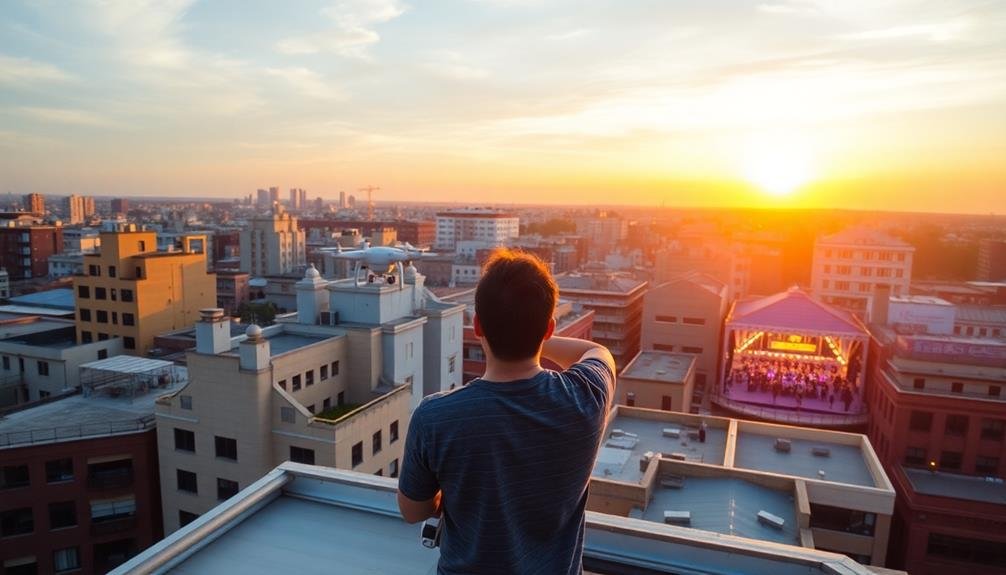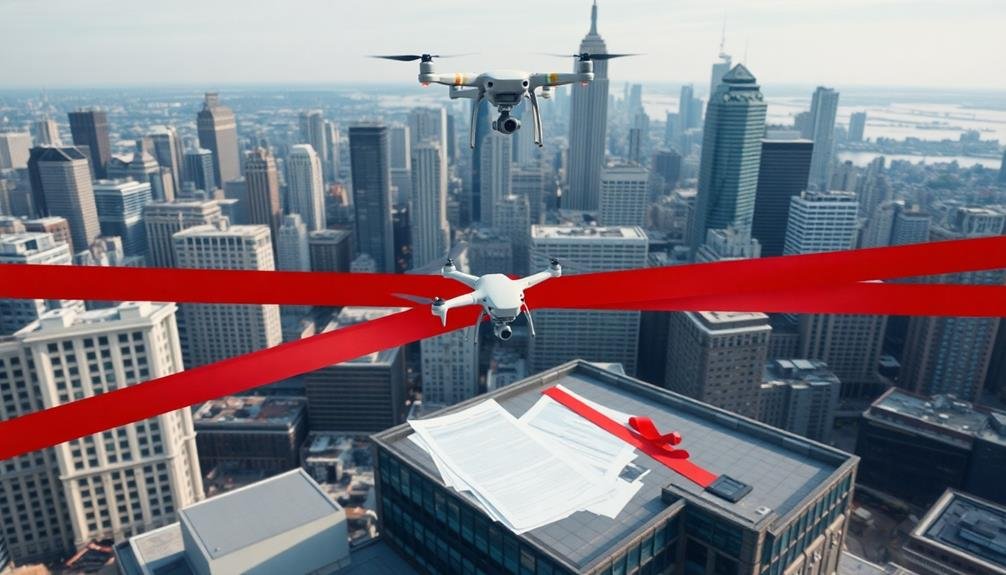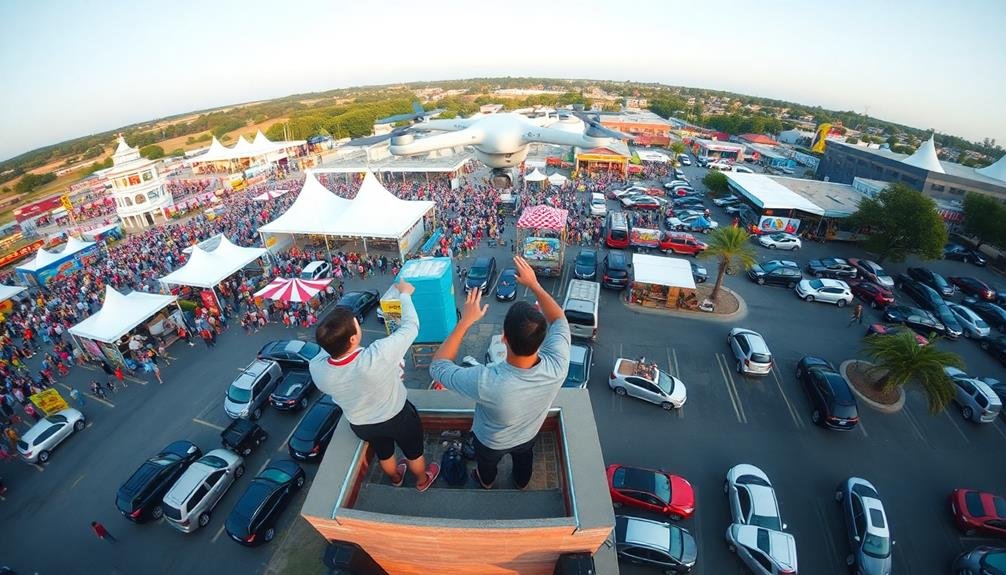To plan aerial photography for a grand opening event, start by scouting safe launch locations with clear lines of sight. Obtain all necessary permits and clearances, including FAA approvals and property owner consent. Choreograph your shot sequences, beginning with wide establishing shots and progressing to specific areas of interest. Coordinate closely with event organizers to align your flight plans with key moments and guarantee smooth operations. Don't forget to prepare backup equipment and contingency plans for potential issues. By following these steps, you'll be well-prepared to capture stunning aerial footage that showcases the event's excitement and scale. The details of each step can make all the difference in your aerial photography success.
Key Takeaways
- Scout and secure ideal launch locations prioritizing safety, line of sight, and terrain suitability for takeoff and landing.
- Obtain necessary permits, including FAA clearances, property owner consent, and event organizer permissions.
- Choreograph shot sequences by storyboarding and planning transitions to capture key moments and crowd energy.
- Coordinate closely with event organizers to align with the timeline and capture desired angles or specific shots.
- Prepare backup equipment and contingency plans for technical issues, weather changes, or unexpected restrictions.
Scout Ideal Drone Launch Locations

The launch pad sets the stage for your aerial photography success. When scouting for ideal drone launch locations, prioritize safety and line of sight.
Look for open areas away from crowds, power lines, and tall structures. You'll want a spot that provides a clear view of the event space while minimizing potential hazards.
Consider the wind direction and strength, as these factors can affect your drone's stability and battery life. Choose a location that offers some shelter from strong gusts if possible.
Assess the terrain for a flat, stable surface to take off and land safely.
Don't forget to account for the sun's position during the event. You'll want to avoid shooting directly into the sun, so plan your launch site accordingly. If you're capturing footage throughout the day, you might need multiple launch locations to maintain ideal lighting conditions.
Ensure your chosen spots comply with local regulations and event organizers' guidelines. Scout these locations well in advance, allowing time to secure necessary permissions and make alternative plans if needed.
Obtain Necessary Permits and Clearances

With your launch locations scouted, it's time to secure the required permits and clearances for your aerial photography. Contact local authorities and event organizers to obtain necessary permissions. You'll need to comply with FAA regulations if you're in the United States, including registering your drone and obtaining a Part 107 license for commercial operations.
Check for any temporary flight restrictions (TFRs) in the area and secure airspace authorization if required. Don't forget to obtain written consent from the property owner or event organizer. Inform local law enforcement about your planned drone operations to avoid misunderstandings.
Here's a quick reference guide for common permits and clearances:
| Permit/Clearance | Issuing Authority | Typical Processing Time |
|---|---|---|
| Drone Registration | FAA | 1-3 business days |
| Part 107 License | FAA | 2-3 weeks |
| Airspace Authorization | FAA | Instant to 90 days |
| Property Owner Consent | Property Owner | 1-7 days |
| Event Organizer Permission | Event Organizer | 1-14 days |
Remember to keep all documentation readily available during your shoot. This guarantees you can quickly address any concerns that may arise on the day of the event.
Choreograph Aerial Shot Sequences

Dancers pirouetting across the sky, your drone's aerial choreography sets the stage for a stunning grand opening event. To create an enthralling sequence, start by storyboarding your shots. Sketch out each frame, considering the event's layout and key moments you want to capture.
Begin with a wide establishing shot to showcase the entire venue. Then, gradually move closer, focusing on specific areas of interest. Plan smooth shifts between shots, using gentle pans and tilts. Incorporate dynamic movements like reveals, where you start behind an object and slowly move to disclose the scene.
Don't forget to capture the crowd's energy. Fly over attendees, but maintain a safe distance. Mix high-altitude shots with lower angles for variety. Consider time-lapse sequences to show the event's progression.
Coordinate with the event organizers to time your shots with key moments, such as ribbon-cutting ceremonies or fireworks displays. Practice your flight patterns beforehand to guarantee smooth execution on the day.
Remember to factor in battery life and have backup drones ready for continuous coverage. By carefully choreographing your aerial shots, you'll create a visually stunning record of the grand opening event.
Coordinate With Event Organizers

Seamless coordination with event organizers is essential for successful aerial photography at grand openings. You'll need to establish clear communication channels and work closely with the event team to guarantee your aerial shots align with their vision and schedule.
Start by requesting a detailed event timeline and agenda. This will help you plan your flight times and shot sequences around key moments like ribbon cuttings or crowd gatherings. Discuss any specific shots or angles the organizers want to capture, and share your ideas for unique aerial perspectives.
You'll also need to coordinate on safety and logistics. Inform organizers about your equipment needs, including drone takeoff and landing areas. Discuss any potential interference with event activities, such as noise concerns or restricted airspace. Work together to identify and mitigate any risks.
Don't forget to synchronize your timing with other media teams. Coordinate with ground-based photographers and videographers to guarantee you're not duplicating efforts or getting in each other's way.
Prepare Backup Equipment and Plans

Backup plans and equipment are essential for aerial photography at grand opening events. You'll need to be prepared for any unforeseen circumstances that could jeopardize your shoot. Start by packing spare batteries, memory cards, and a backup camera. Don't forget to bring extra propellers and a secondary drone in case your primary one malfunctions.
Create a contingency plan for various scenarios. If weather conditions become unfavorable, have alternative shooting angles or ground-based options ready. Prepare for potential airspace restrictions by researching nearby locations where you can still capture impressive aerial shots. If technical issues arise, guarantee you have troubleshooting guides and tools on hand.
Consider bringing a skilled assistant who can help with equipment setup and act as a spotter during flights. They can also step in if you're unable to operate the drone.
Familiarize yourself with the event's schedule and have a plan for each key moment you need to capture. By anticipating potential problems and having solutions ready, you'll be able to deliver high-quality aerial footage regardless of any challenges that may arise during the grand opening event.
Frequently Asked Questions
What Types of Drones Are Best for Aerial Photography at Grand Opening Events?
You'll want to contemplate compact, easy-to-maneuver drones with high-quality cameras. DJI's Mavic series or Autel's EVO line are excellent choices. They're lightweight, offer 4K video, and have obstacle avoidance features for safer operation in crowded events.
How Much Does Professional Aerial Photography Typically Cost for Such Events?
You'll typically pay $500-$2000 for professional aerial photography at grand opening events. Costs vary based on event duration, drone type, and photographer's experience. Don't forget to factor in editing and post-production fees when budgeting.
What Weather Conditions Are Ideal for Drone Photography at Outdoor Events?
You'll want clear skies, low wind, and mild temperatures for ideal drone photography at outdoor events. Avoid rain, fog, or strong gusts. Early morning or late afternoon light often provides the best conditions for stunning aerial shots.
How Long Does It Take to Edit and Deliver Aerial Footage After the Event?
You'll typically need 1-3 days to edit and deliver aerial footage after an event. It depends on the amount of footage, desired editing complexity, and your skill level. Rush delivery may be possible for an additional fee.
Can Aerial Photography Be Combined With Ground-Level Videography for a Complete Package?
Yes, you can definitely combine aerial photography with ground-level videography for a thorough package. It'll give you diverse perspectives, creating a more dynamic and engaging final product that showcases your event from multiple angles.
In Summary
You've now got the key elements to capture stunning aerial footage of your grand opening event. Remember to stay flexible and communicate clearly with your team. On the big day, arrive early to set up and do final checks. Keep safety as your top priority throughout. With proper planning and execution, you'll create breathtaking aerial visuals that'll make your event truly memorable. Now get out there and make some cinematic magic!

As educators and advocates for responsible drone use, we’re committed to sharing our knowledge and expertise with aspiring aerial photographers.




Leave a Reply